Leo is one of the twelve zodiac constellations located in the northern celestial hemisphere. It is the 12th largest constellation in the sky out of the 88 modern constellations.
Key Facts & Summary
- Leo is one of the first 48 constellations listed by the Greco-Roman astronomer Ptolemy, in his 2nd century Almagest.
- Now part of the 88 modern constellations, Leo is the 12th largest constellation in the sky occupying an area of around 947 square degrees.
- Leo contains five Messier objects, the galaxies Messier 65, Messier 66, Messier 95, Messier 96, and Messier 105.
- Three galaxies, namely Messier 65, Messier 66, and NGC 3628 are part of the small group of galaxies named the Leo Triplet.
- There are two meteor showers associated with the constellation of Leo, they are the Leonids and the January Leonids.
- The brightest star in Leo is Regulus, a blue-white main-sequence star with an apparent magnitude of 1.40.
- Regulus is also the 21st brightest star in the night sky, and it is actually a quadruple star system formed out of four stars organized into two pairs.
- Regulus is located at the base of the most prominent asterism of Leo, namely The Sickle of Leo – which consists of a couple of stars that outline the mane of the celestial Lion.
- Together with Spica and Arcturus, Regulus also forms another asterism known as the Spring Triangle.
- Apart from this star, there are other interesting stars in Leo, such as Denebola, Algieba, Zosma, Algenubi, Adhafera, Iota Leonis, Tau Leonis, Rasalas, Chertan, Wolf 359, CW Leonis, or Caffau’s Star.
- Currently, around 13 stars have been discovered to host planets in Leo.
- Apart from the aforementioned Messier objects, there are other eye-catching deep-sky objects in Leo, such as the Leo Ring, NGC 2903, the Clowes-Campusano LQG, U1.11, and the Huge-LQG.
The constellation of Leo is one of the earliest recognized constellations in the sky. Some archaeological evidence backs up the claim that the Mesopotamians had a similar constellation as early as 4000 BCE.
This constellation is associated with the Nemean Lion from Greek mythology, who was killed by Hercules / Heracles – during the first of his twelve labors.
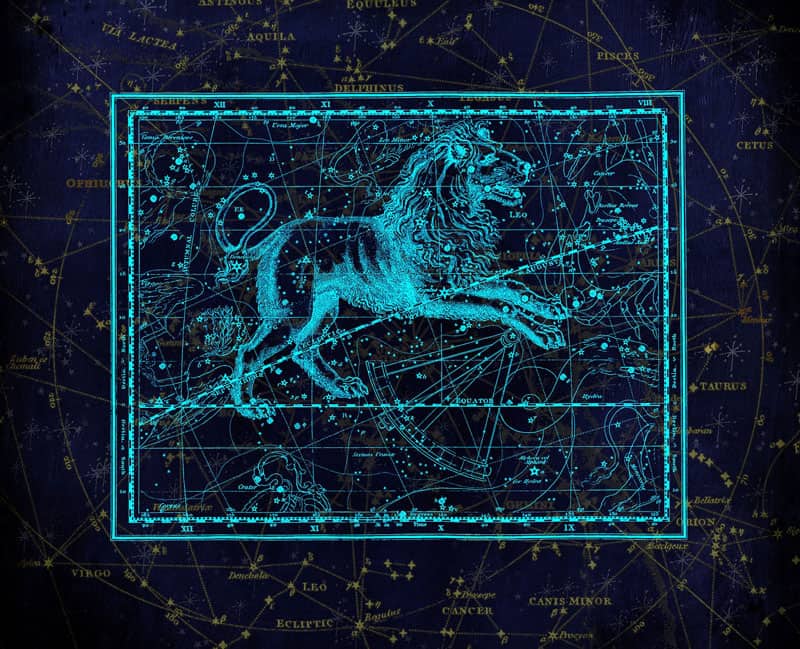
The story tells us that the Nemean Lion would take women as hostages to its lair in a cave, thus luring warriors from the nearby towns to save them.
The Lion was impervious to any weaponry, and as such, clubs, swords, and spears were useless against it. Hercules realized that he would have to defeat the lion with his bare hands.
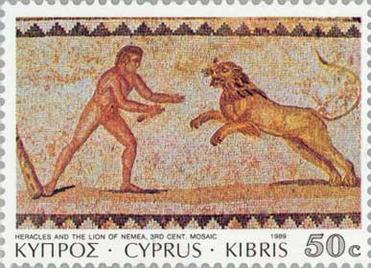
When Hercules approached the lion’s cave, the lion jumped at him, but Hercules caught the beast in mid-air, with one hand grasping the lion’s forelegs and the other its hind legs.
He bent the lion backward, breaking its back and thus freeing the captured women. Zeus commemorated this labor by placing the Lion in the sky.
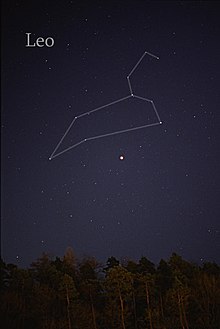
Location
The constellation of Leo is the 12th largest constellation in the sky. Leo spreads out for over 947 square degrees, being located in the second quadrant of the northern hemisphere (NQ2), where it can be seen at latitudes between +90o and -65o.
- Right Ascension: 11h
- Declination: +15o
- Visible: between +90o and -65o.
- Best viewed: at 21:00 (9 p.m.) during April
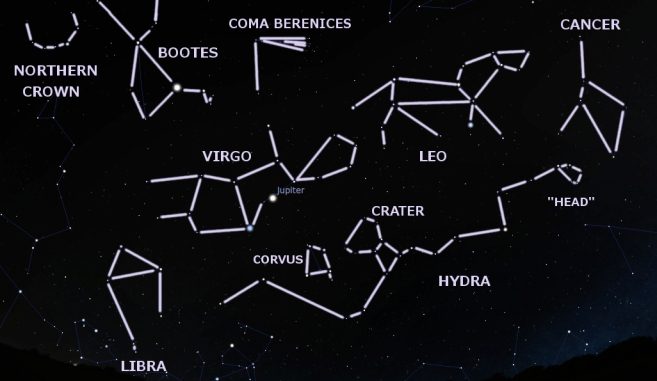
Leo is bordered by the constellations of Cancer, Coma Berenices, Crater, Hydra, Leo Minor, Lynx, Sextans, Ursa Major, and Virgo. Leo is part of the zodiac family of constellations along with Aries, Taurus, Gemini, Cancer, Virgo, Libra, Scorpius, Sagittarius, Capricornus, Aquarius, and Pisces.
Messier Objects
The constellation of Leo hosts five Messier objects, Messier 65, Messier 66, Messier 95, Messier 96, and Messier 105. All of them are bright galaxies.
Messier 65
Messier 65, also designated as NGC 3623, is an intermediate spiral galaxy in Leo, located at around 35 million light-years away from Earth.
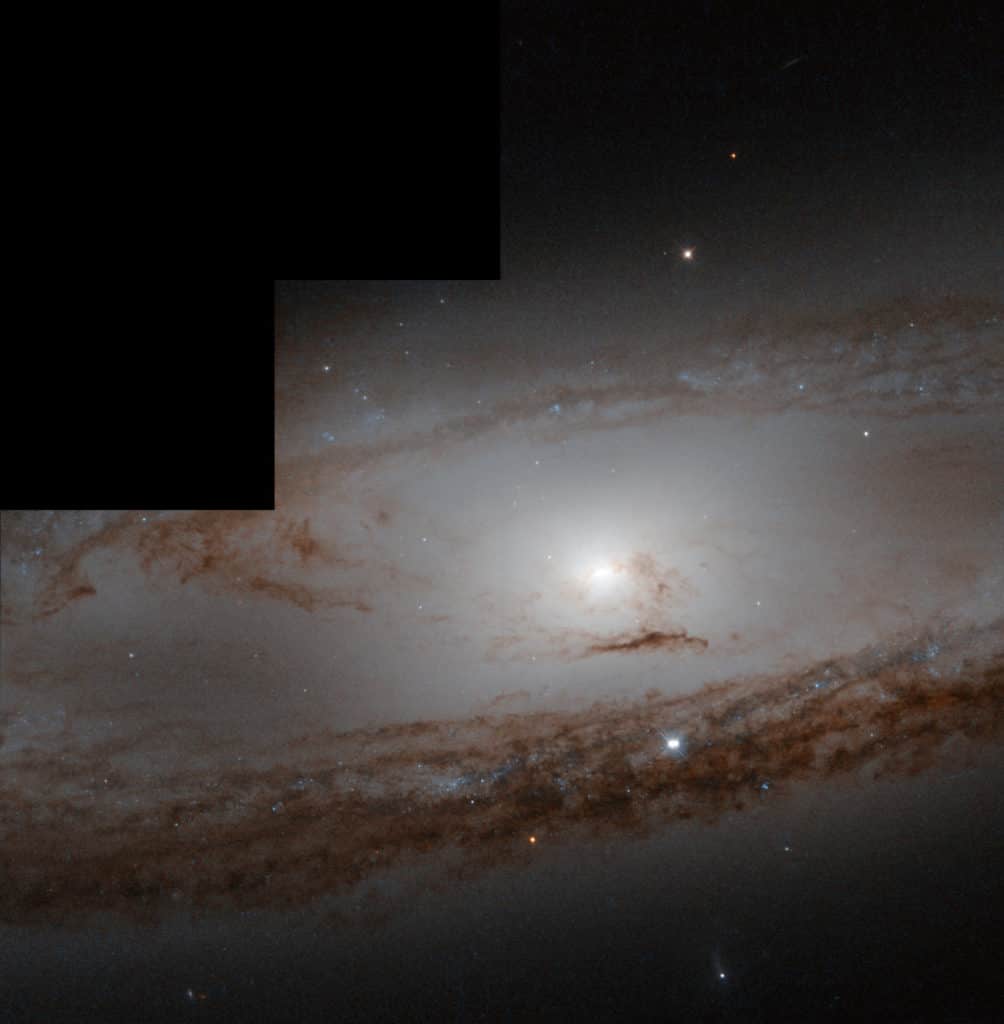
It was discovered in 1780 by Charles Messier, and it has an apparent magnitude of 10.25. This galaxy is low in dust and gas, and little star formation is active in it.
Messier 66
Messier 66, also designated as NGC 3627, is an intermediate spiral galaxy located at around 31 million light-years away from us. It is around 95,000 light-years across.
This galaxy has a weak bar feature and loosely wound arms, with most of its mass concentrated in its center. Messier 66 has an apparent magnitude of 8.9.
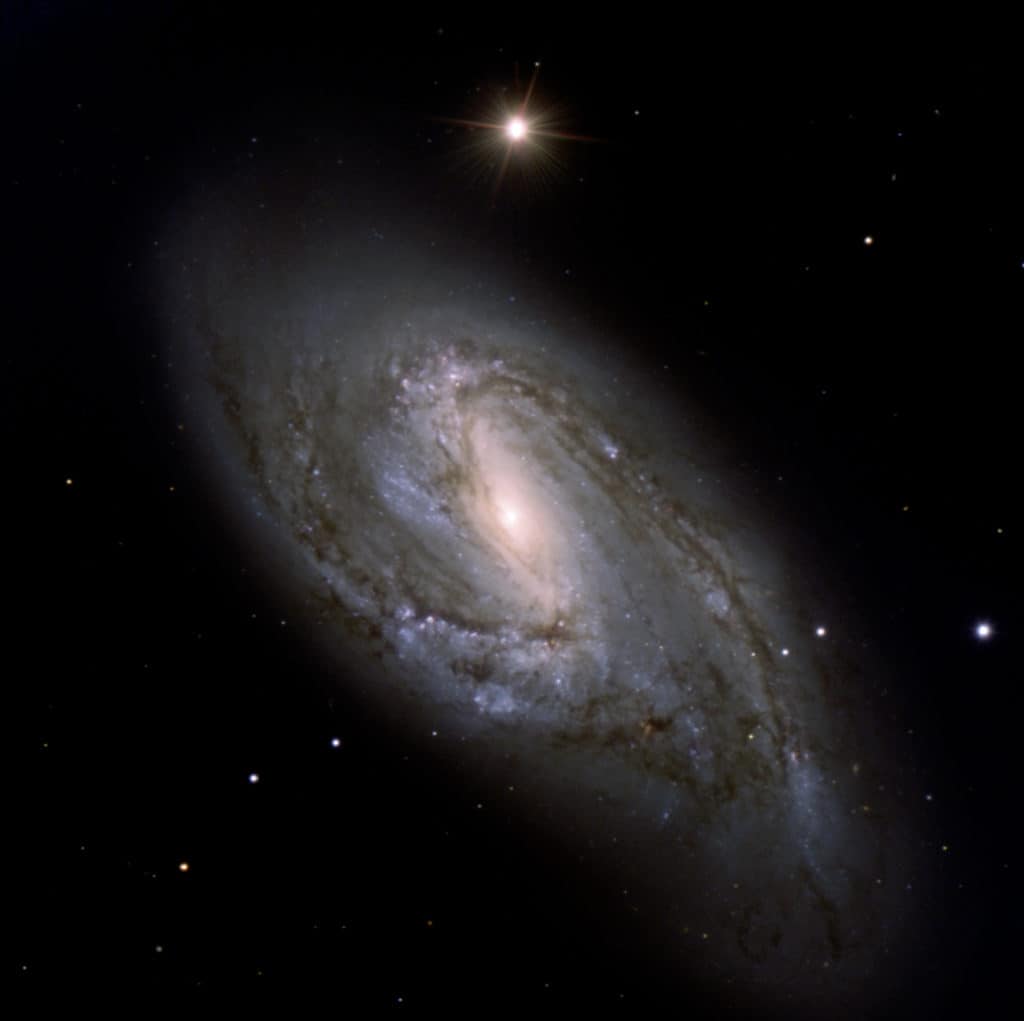
Messier 66, along with Messier 65 and NGC 3628, is part of the Leo Triplet – a group of related galaxies in Leo.
Messier 95
Messier 95, also designated as NGC 3351, is a barred spiral galaxy located at around 33 million light-years away from us. Messier 95 has an apparent magnitude of 11.4.
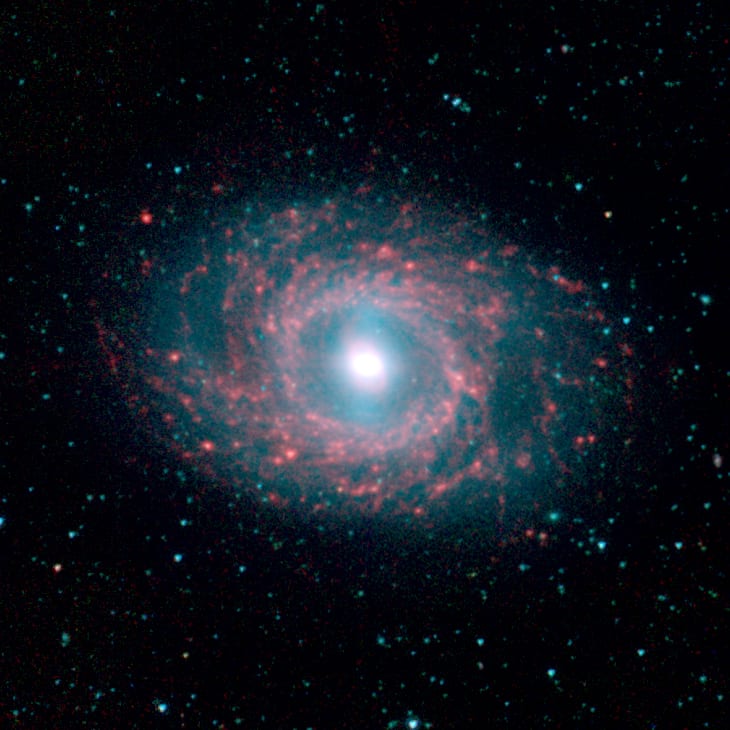
This galaxy along with Messier 96 and Messier 105, is part of the M96 group of galaxies, which contains anywhere between 8 to 24 galaxies that are related.
Messier 96
Messier 96, also designated as NGC 3368 is an intermediate spiral galaxy located at around 31 million light-years away from us. Messier 96 has an apparent magnitude of +10.1, it can be seen with a telescope of 25.4 cm (10.0 in) aperture, the galaxy being visible as a 3 x 5 arcminute halo with a brighter core region.

Messier 96 is almost the same size as our Milky Way galaxy. This galaxy is the brightest in the M96 group of galaxies. The M96 group of galaxies is the nearest galaxy group to Earth.
Messier 105
Messier 105, also designated as NGC 3379, is an elliptical galaxy located at around 36.6 million light-years away from us. This galaxy is confirmed to have a supermassive black hole at its center.

Messier 105, along with the barred lenticular galaxy NGC 3384, are surrounded by an enormous ring of neutral hydrogen with a radius of 200 kiloparsecs. This galaxy has an apparent magnitude of 10.2.
Notable Stars
Apart from Regulus, there are other interesting stars in Leo, such as Denebola, Algieba, Zosma, Algenubi, Adhafera, Iota Leonis, Tau Leonis, Rasalas, Chertan, Wolf 359, CW Leonis, or Caffau’s Star. Currently, around 13 stars have been discovered to host planets in Leo.
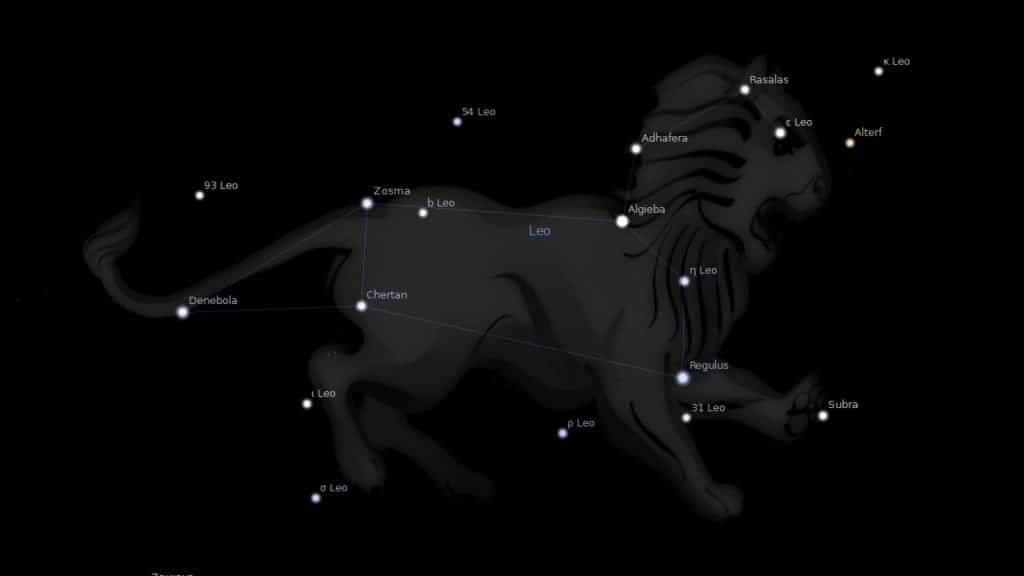
Regulus
Regulus, designated as Alpha Leonis, is the brightest star in Leo, and the 21st brightest star in the night sky, having an apparent magnitude of 1.40. It is located at 79 light-years from us.
Regulus isn’t a single star, but rather a quadruple star system composed out of two stars organized into two pairs. The brightest star, Regulus A, is a blue-white main-sequence star, that is most likely orbited by a white dwarf.
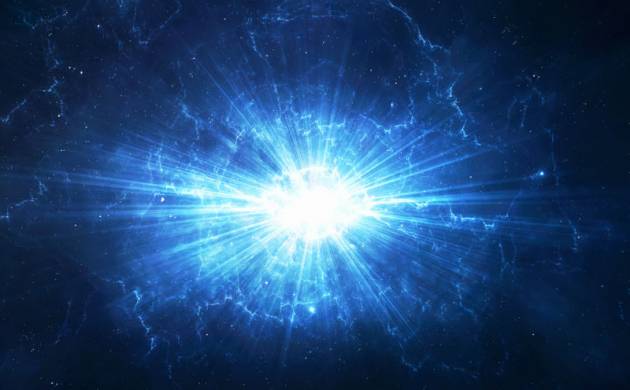
Regulus is a subgiant star, having 380% of our Sun’s mass, 309% of its radius, and it is 288 times brighter than the Sun. The temperatures on Regulus have been estimated around 12,460 K, around twice as hot as our Sun.
Together with Spica from Virgo constellation, and Arcturus from Bootes, Regulus forms the famous asterism known as the Spring Triangle.
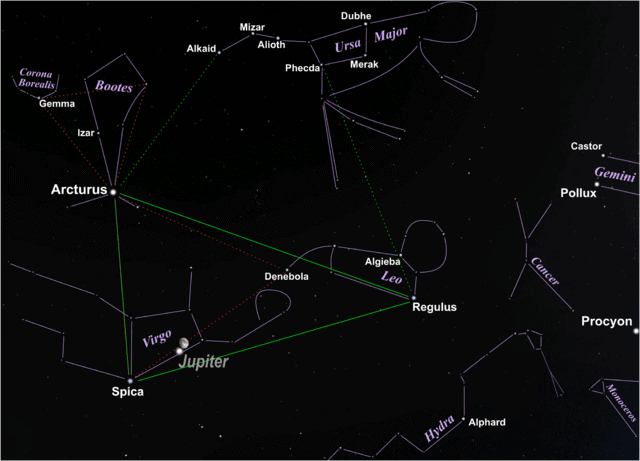
Regulus is a fast-spinning star, with a rotational velocity recorded at 318 km / 197.5 mi per second. Because of this, the star is highly oblate in shape. The star is at its 96.5% of its critical angular velocity break-up.
Another consequence is the so-called gravity darkening effect – the photosphere at the star’s poles is hotter, and five times brighter than its equatorial region. Regulus is emitting polarized light because of this.
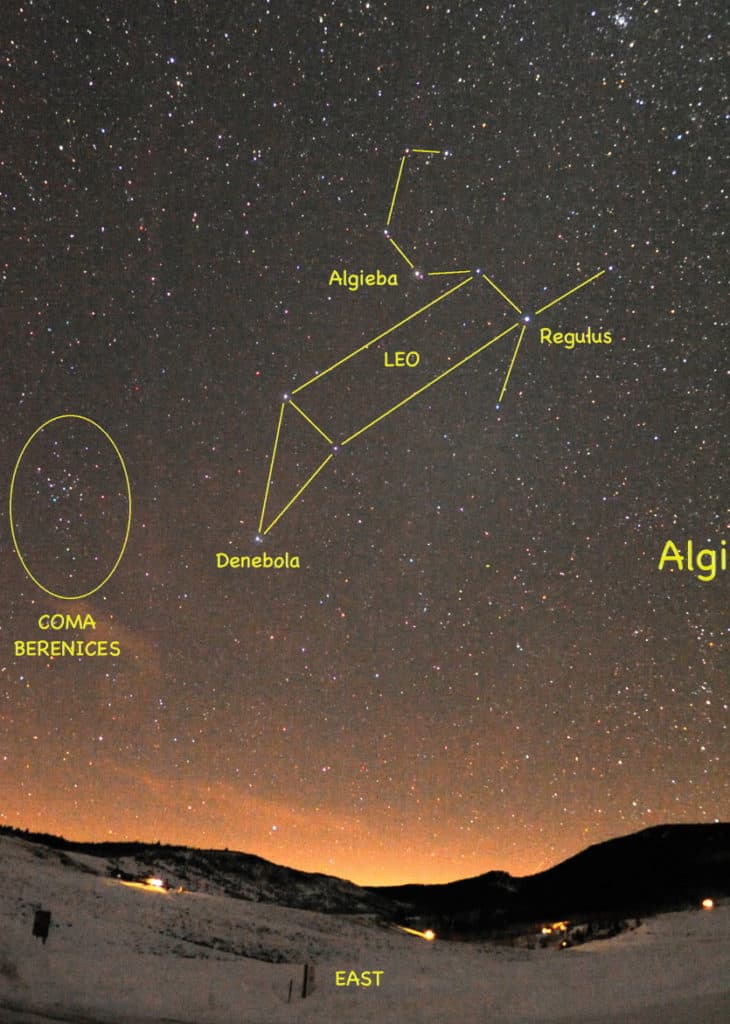
Regulus is located at the base of the most prominent asterism of Leo, namely The Sickle of Leo – which consists of a couple of stars that outline the mane of the celestial Lion.
Denebola
Denebola, also designated as Beta Leonis, is the second-brightest star in Leo, having an apparent magnitude of 2.113. This star is located at around 35.9 light-years away from our Solar System.
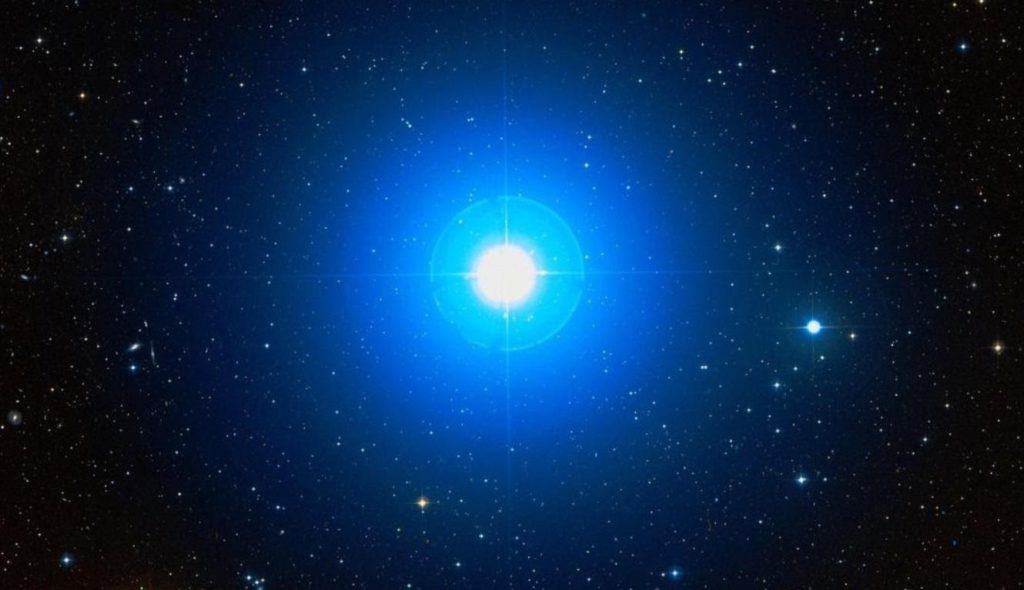
Denebola is an A-type main-sequence star that is 178% more massive than our Sun, having almost twice its radius. Denebola is 15 times brighter than our Sun, and it is hotter with temperatures reaching 8,500 K.
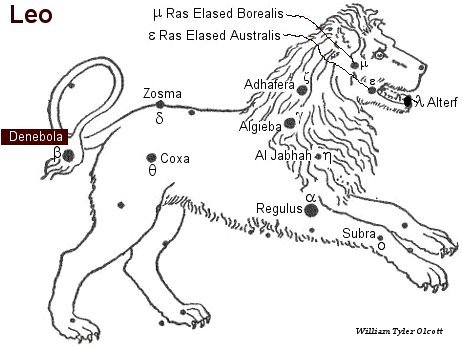
Denebola, along with Arcturus and Spica, is part of the Spring Triangle asterism, and also of the Great Diamond together with the star Cor Caroli.
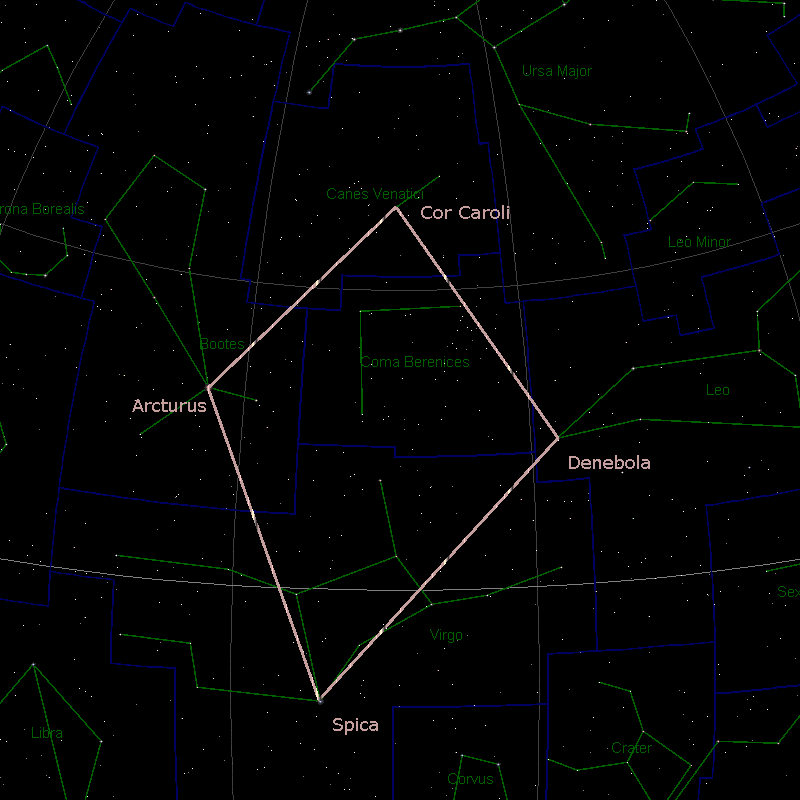
Algieba
Algieba, designated as Gamma Leonis, is a binary star system in Leo, located at around 130 light-years away from us. The primary star is a K-type giant, while the second star is a G-type giant.
Algieba has a visual magnitude of around 2.08, being the third brightest star in Leo. The primary orange-red star has 123% of our Sun’s mass, 3,188% of its radius, and it is 320 brighter than our Sun.
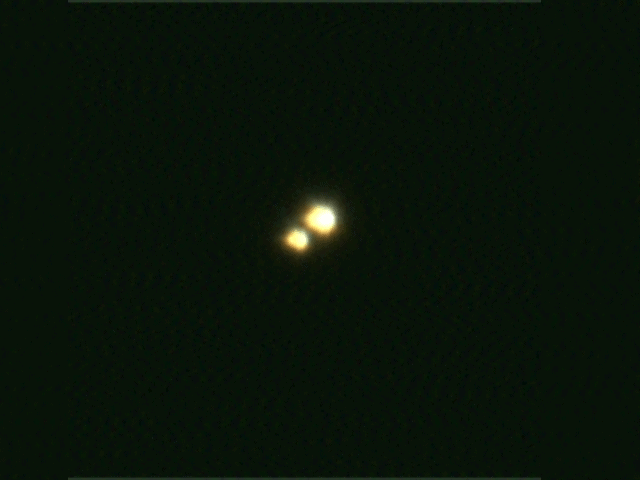
The secondary yellowish giant star has 1,000% of our Sun’s radius, and it is 40 times brighter. Recently, the primary star, Algieba A, has been confirmed to host a planet, that has around 2.14 times the mass of Jupiter.
Zosma
Zosma, designated as Delta Leonis, is the fourth brightest star in Leo, having an apparent magnitude of 2.56. Zosma is located at around 58.4 light-years away from the Sun.
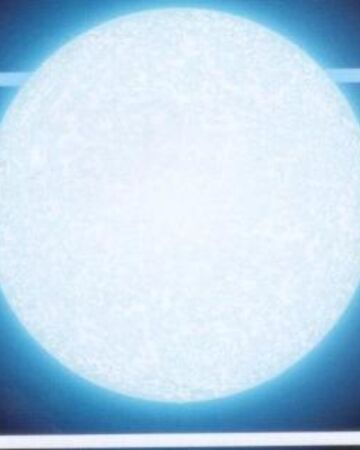
Zosma is an A-type main-sequence star, that has around 220% of our Sun’s mass, 214% of its radius, and it is 15.5 times brighter than our Sun. This star is also a fast spinner, having a rotational velocity of around 180 km / 111.8 mi per second.
Algenubi
Algenubi, designated as Epsilon Leonis, and also known as Ras Elased Australis, is the fifth brightest star in Leo, having an apparent magnitude of 2.98.

Algenubi is located at around 247 light-years away from Earth, and it is a giant G-type star. Algenubi has around 401% of our Sun’s mass, 2,100% of its radius, and it is 288 times brighter.
Adhafera
Adhafera, designated as Zeta Leonis, is the seventh brightest star in Leo, having an apparent magnitude of 3.33. It is located at around 274 light-years away from us.
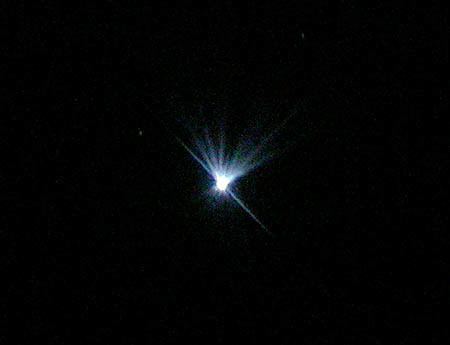
Adhafera is a giant star having 300% of our Sun’s mass, 600% of its radius, and it is 85 times brighter. Adhafera is also hotter than our Sun, having temperatures of around 6,792 K.
Iota Leonis
Iota Leonis is the 14th brightest star in Leo, having an apparent magnitude of 4.00. Iota Leonis is a triple star system, located at around 79 light-years away from us.
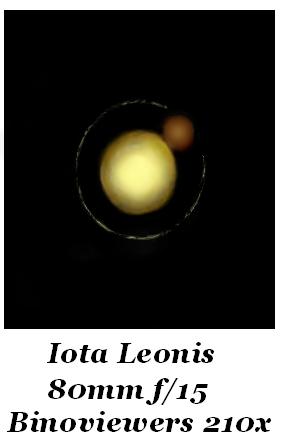
The primary star is an F-type subgiant that has around 162% of our Sun’s mass, 210% of its radius, and it is 11.5 times brighter than our Sun.
Tau Leonis
Tau Leonis is the 31st brightest star in Leo, having an apparent magnitude of 5.00. This star is located at around 560 light-years away from us.
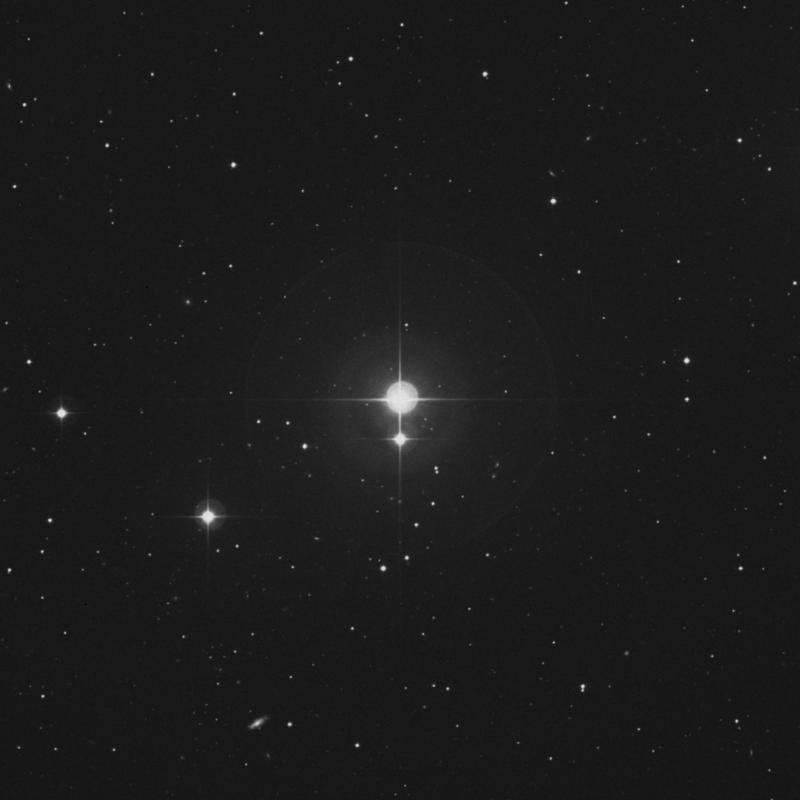
Tau Leonis is a G-type giant star that is currently expanding its outer layers. Currently, Tau Leonis has around 390% of our Sun’s mass, 2,515% of its radius, and it is 329.6 times brighter than our Sun.
Rasalas
Rasalas, designated as Mu Leonis, is the 13th brightest star in Leo, having an apparent magnitude of 3.88. This star is located at around 124.1 light-years away from us.
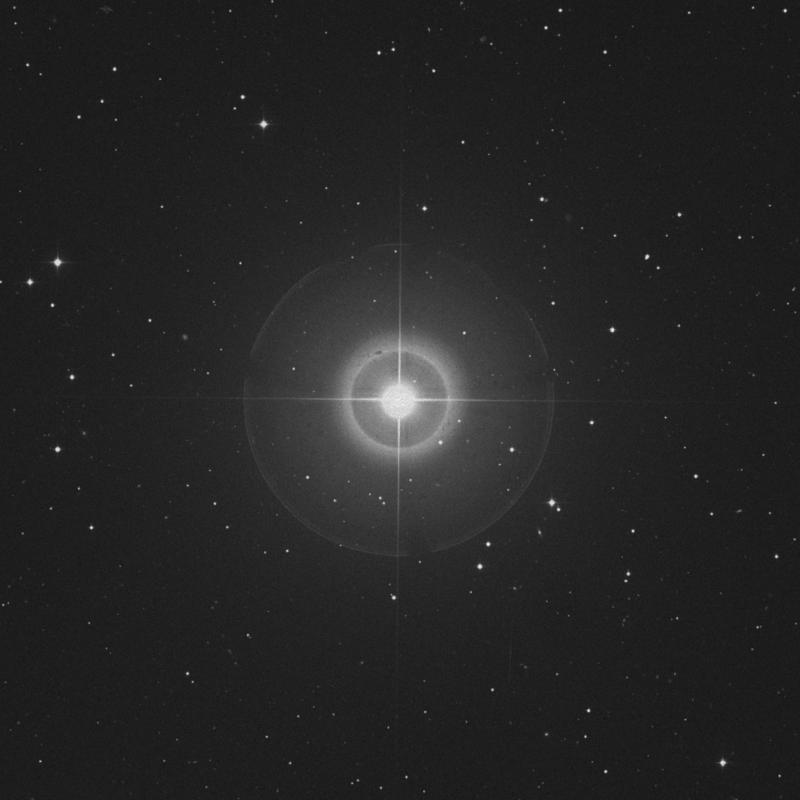
Rasalas is an evolved K-type giant star with strong absorption lines of cyanogen and calcium in its spectrum. This star has around 150% of our Sun’s mass, 1,400% of its radius, and it is 63 times brighter.
In 2014, a planet was confirmed to orbit Rasalas. This companion appears to be 2.4 times as massive as Jupiter, and it completes one orbit around its star once every 358 days.
Chertan
Chertan, designated as Theta Leonis, is the 6th brightest star in Leo, having an apparent magnitude of +3.324. This star is located at around 165 light-years away from us.
Chertan is an A-type main-sequence star, however, its spectrum shows strong absorption lines of metals, marking it as a chemically peculiar Am star.
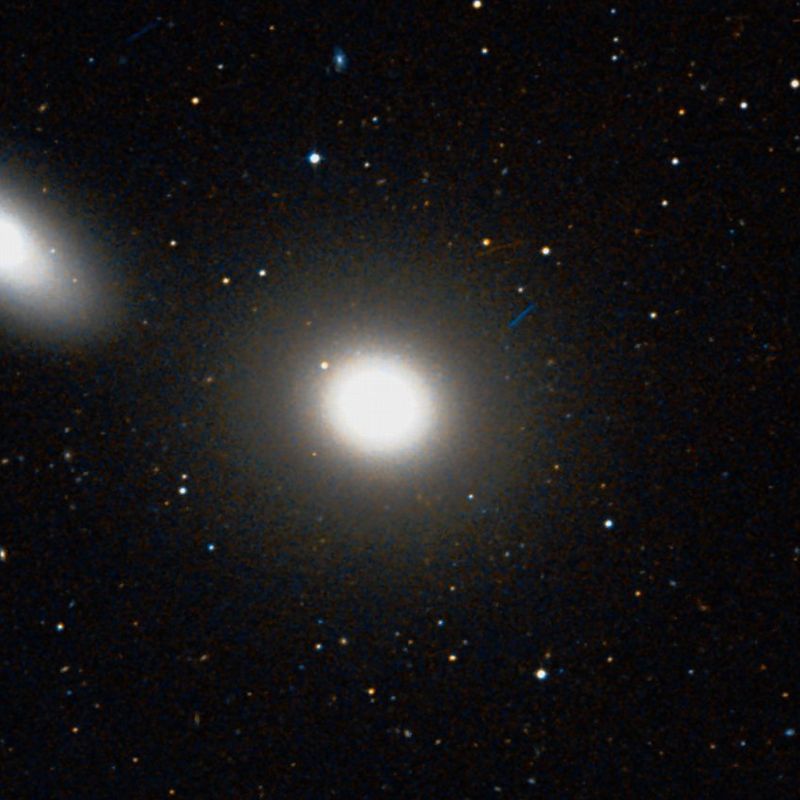
This star’s metallicity appears to be 12% higher than in our Sun. Chertan is also surrounded by a circumstellar disk of gas and dust that stretches across space for around 36 AU.
Chertan has around 250% of the mass of our Sun, and it is 141 brighter. The temperatures on Chertan are also greater, 9,350 K.
Wolf 359
Wolf 359 is a red dwarf star located at only 7.9 light-years away from Earth. This star also hosts 2 exoplanets. It is a faint star, having an apparent magnitude of 13.54.
Wolf 359 is among the nearest stars to the Sun, the fifth closest. Wolf 359 is smaller than our Sun, having only 9% of its mass, and 16% of its radius.
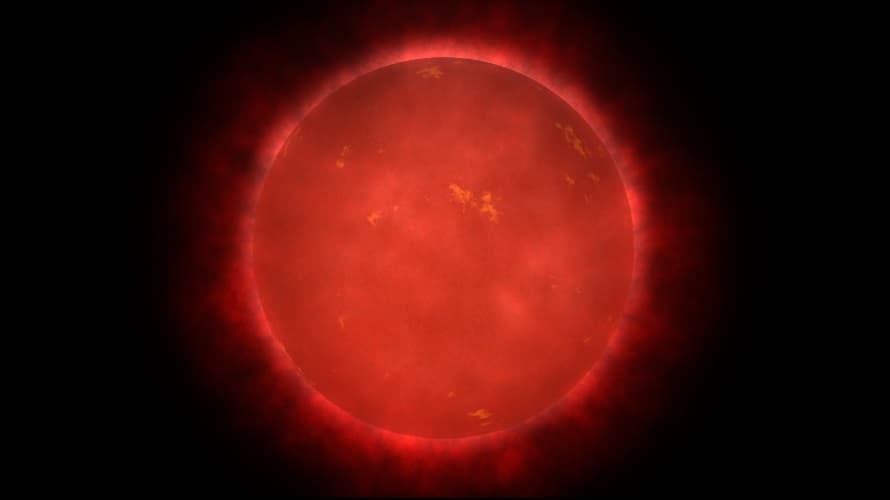
This star is also much cooler than our Sun, with its temperatures reaching only 2,800 K. The two exoplanets discovered in 2019 are both more massive than Earth.
The first planet, termed as “c”, has 3.8 Earth masses, while the other, termed “b”, has 43.9 Earth masses.
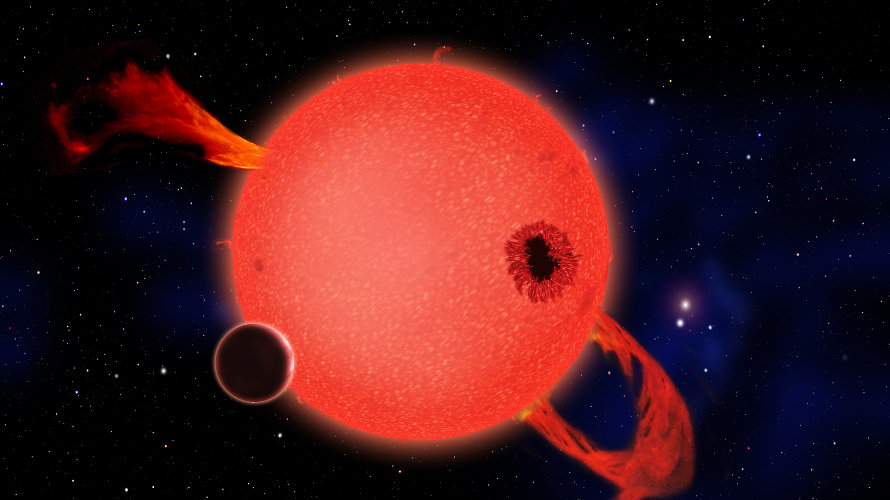
R Leonis
R Leonis is a red giant Mira-type variable star located at around 300 light-years away from us. The apparent magnitude of this star varies between 4.31 and 11.65 within a period of 312 days.
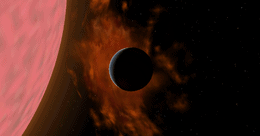
This giant star is less massive than our Sun, having only 70% of its mass, yet its radius is far greater, having around 29,900% of our Sun’s radius. A planet is theorized to orbit R Leonis, which would have less than two Earth masses, however, it is still unconfirmed.
R Leonis is 5,617 times brighter than our Sun, however, its surface temperatures reach only at around 2,890 K, less than our Sun.
Gliese 436
Gliese 436 is a red dwarf star located at around 31.8 light-years away from us. It has an apparent magnitude of 10.67, and it may host more than one planet.
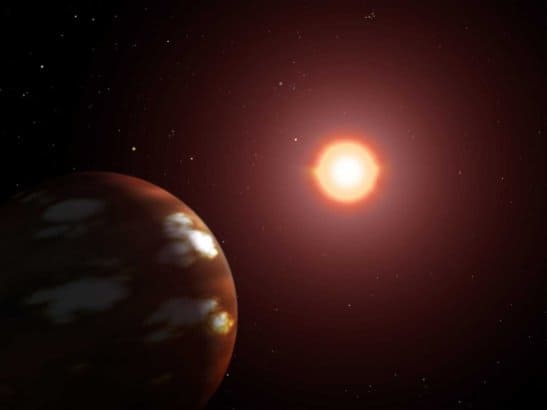
The first official confirmed planet around this star is designated as Gliese 436b, and it has around 21 Earth masses. However, many speculate that a second planet, similar to Earth, or less massive, could be there as well.
IRC +10216
IRC +10216, also designated as CW Leonis, is a carbon star that is embedded in a thick dust envelope. It is a Mira-type variable star, with its brightness varying from 10.96 to 14.80.
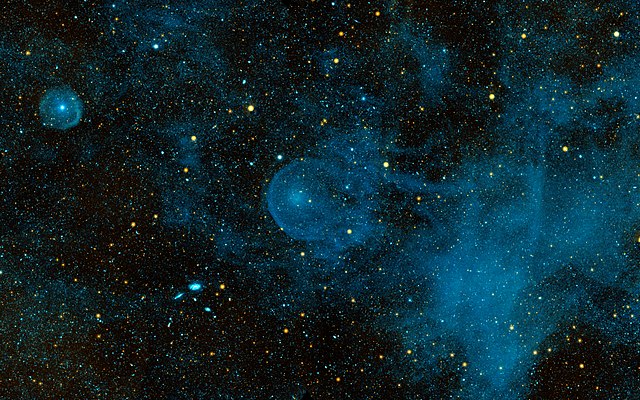
CW Leonis is located at around 120 parsecs away from us, and the astrosphere surrounding this star is 84,000 AU. CW Leonis has around 70% of our Sun’s mass, while its radius is estimated to be at around 56,000% that of the Sun.
The star is quite bright, being 8,500 times brighter than our Sun on average, while also reaching a maximum of 11,850 brighter.
Caffau’s Star
Caffau’s Star, designated as SDSS J102915+172927 is a Population II star in the galactic halo, which is around 13 billion years old, making it one of the oldest stars in the galaxy.

When it was discovered, it had the lowest metallicity of any known star. Caffau’s Star has an apparent magnitude of +16.92, and it has only 80% of our Sun’s mass.
This star is highly deficient in carbon, nitrogen, oxygen, and completely devoid of lithium. Since carbon and oxygen provide a fine structure cooling mechanism that is critical in the formation of low-mass stars, the origins of Caffau’s Star is somewhat mysterious.
Al Jabbah
Al Jabbah, designated as Eta Leonis, is a white supergiant star with an apparent magnitude of 3.511. It is around 2,000 light-years away from us.
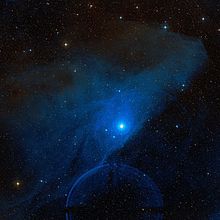
Al Jabbah is around 5,600 times brighter than our Sun, and it is a suspected variable star.
Deep-sky Objects
Apart from the aforementioned Messier objects, there are many interesting deep-sky objects in Leo, such as the Leo Ring, NGC 2903, the Clowes-Campusano LQG, U1.11, and the Huge-LQG among others.
NGC 3628
NGC 3628, also known as the Hamburger Galaxy or Sarah’s Galaxy, is an unbarred spiral galaxy situated at around 35 million light-years away from the Solar System.
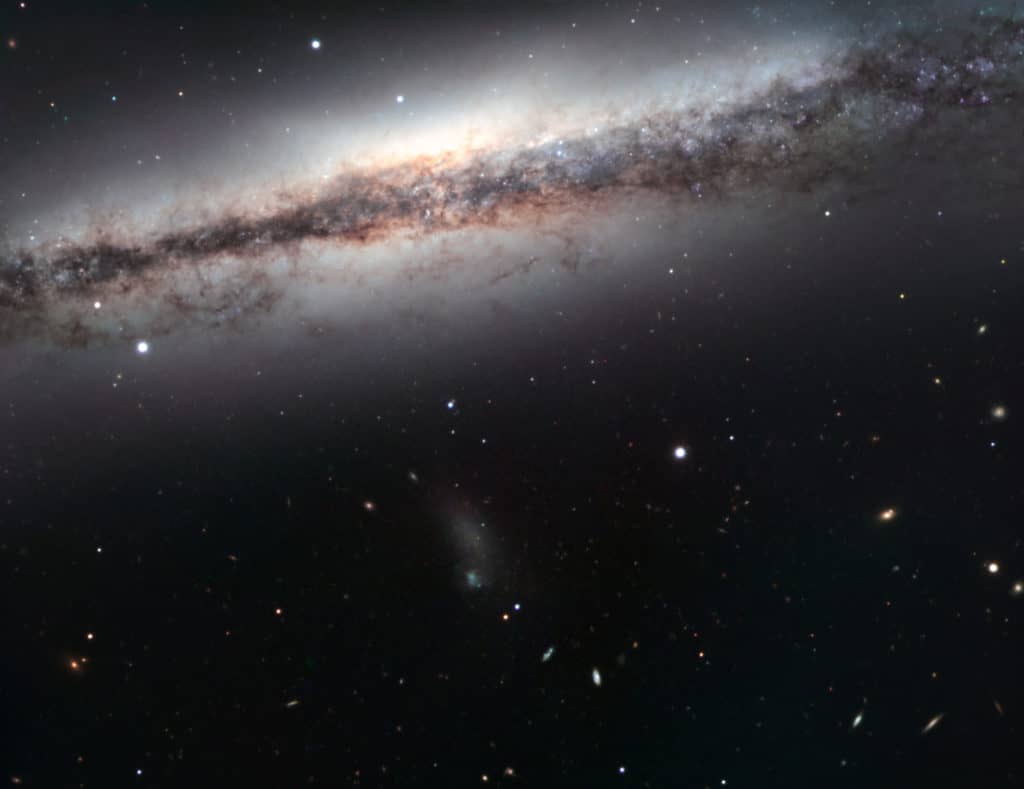
NGC 3628 has a long tidal tail, of around 300,000 light-years. This galaxy has an apparent magnitude of 10.2, and together with M65 and M66, forms the Leo Triplet, a small group of galaxies.
The Leo Ring
The Leo Ring is an enormous intergalactic cloud of hydrogen gas that stretches for around 650 kilo light-years / 200 kiloparsecs in diameter, in orbit of two galaxies.
The Leo Ring is situated at the center of the Leo Group of galaxies. The Leo Ring formed around 1 billion years ago when NGC 3384 collided with Messier 96, at the heart of the Leo Group.
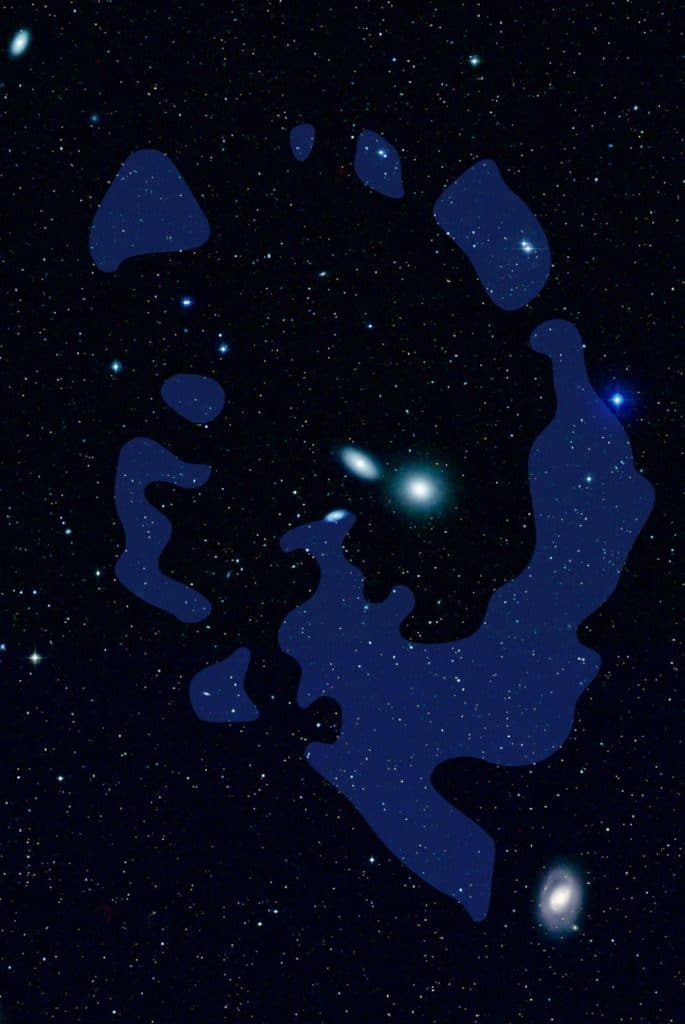
This resulted in the expulsion of a galaxy’s worth of gas into intergalactic space, the gas gathered into a vast set of clouds. The two galaxies that collided drifted around 38 million light-years apart and the ring is now 650-kilo light-years / 200 kiloparsecs wide.
NGC 2903
NGC 2903 is a field barred spiral galaxy situated at around 30 million light-years away. It was discovered in 1784 by William Herschel. This galaxy has a high rate of star formation in its central region.
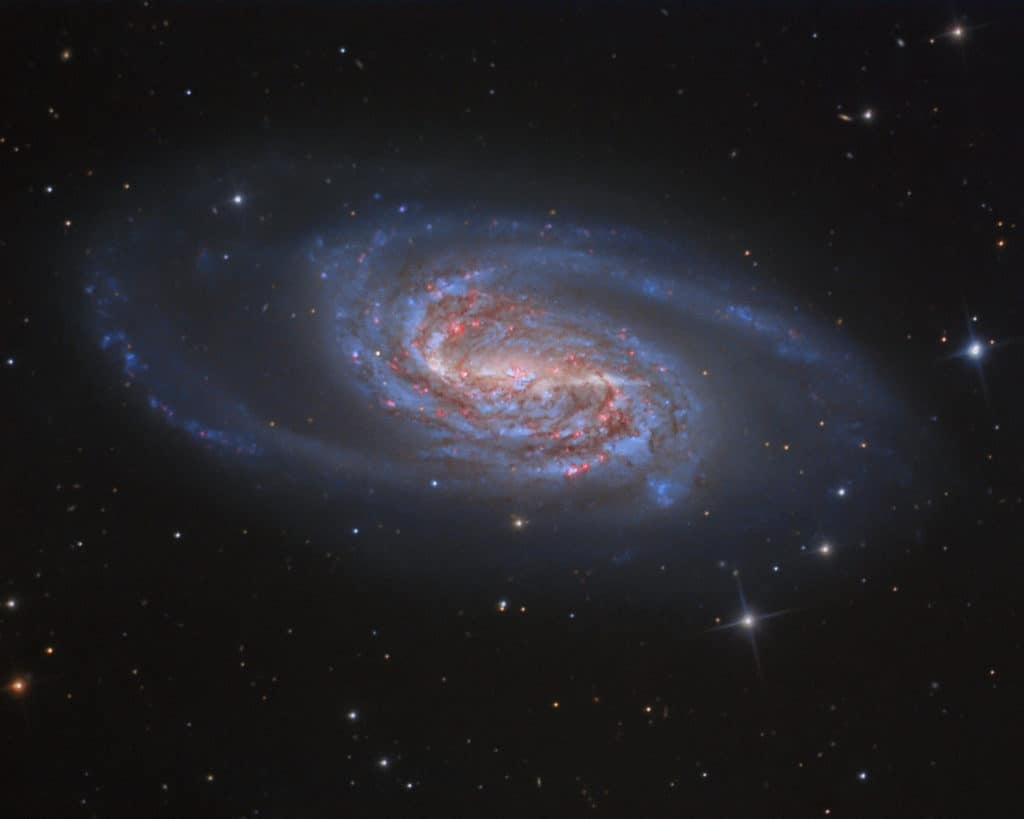
This galaxy is part of the Virgo Supercluster, and it is quite a bright galaxy, having an apparent magnitude of 8.8. NGC 2903 has 100,000 light-years in diameter.
The Clowes-Campusano LQG
The Clowes-Campusano LQG is a large quasar group, consisting of around 34 quasars, and measures around 2 billion light-years across. It is among the largest known superstructures in the observable universe.
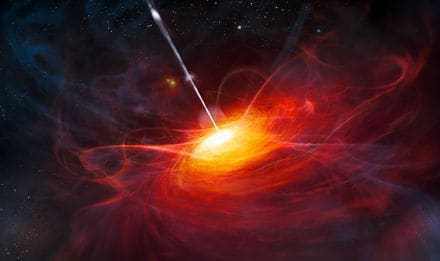
This quasar group is located near its larger cousin, the Huge LQG. The quasars are powerup by highly luminous supermassive black holes, spanning a region roughly 2 billion light-years in length, and around 1 billion light-years wide. The Clowes-Campusano LQG is located at around 9.5 billion light-years away from us.
U1.11
U1.11 is another large quasar group, located in Leo and Virgo. It is among the largest LQG’s known, with an estimated diameter of 2.2 billion light-years, and contains around 38 quasars.
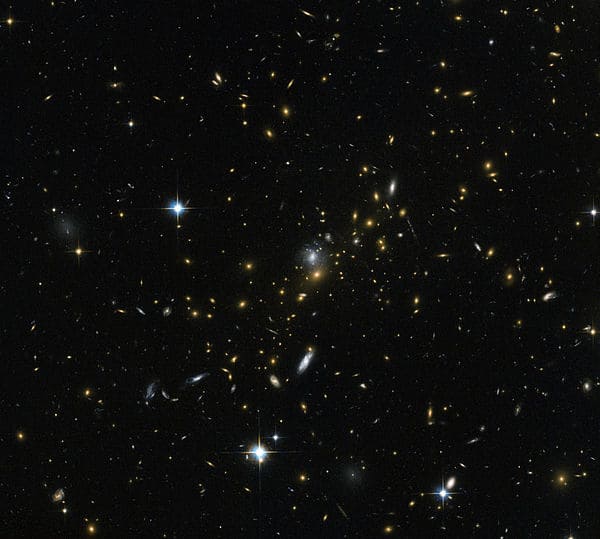
The Huge LQG
The Huge LQG, also designated as U1.27, is a possible structure or pseudo-structure of 73 quasars that measure around 4 billion light-years across.
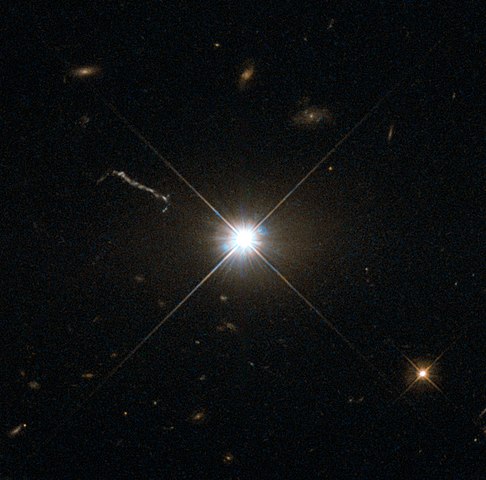
When it was discovered, it held the title of the largest and most massive known structure in the universe, until the Hercules Corona Borealis Great Wall was discovered, which stretches for around 10 billion light-years.
Hercules Corona Borealis Great Wall
The Hercules-Corona Borealis Great Wall, or the Great GRB Wall, is presumably the largest known structure in the observable universe, stretching for around 10 billion light-years.
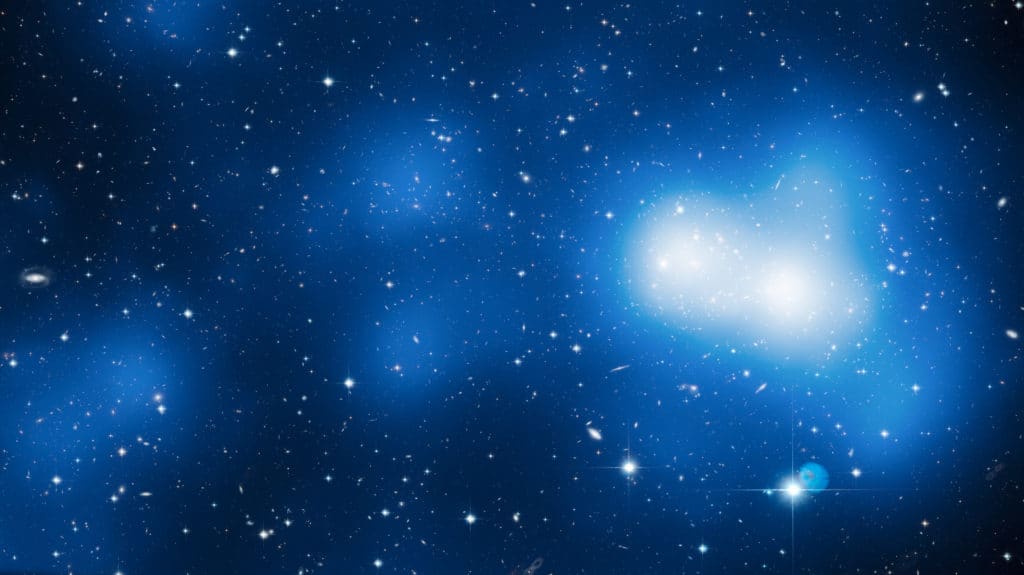
There are many conflicting views upon its existence, however, this structure is presumed to stretch from the second to the Third and Fourth galactic quadrants, thus it lies in the northern hemisphere, being part of many constellations.
NGC 3593
NGC 3593 is a lenticular galaxy, and a starburst galaxy, meaning it is still forming new stars at a high rate. A single spiral arm is present in this galaxy, which spirals outwards from its ring.
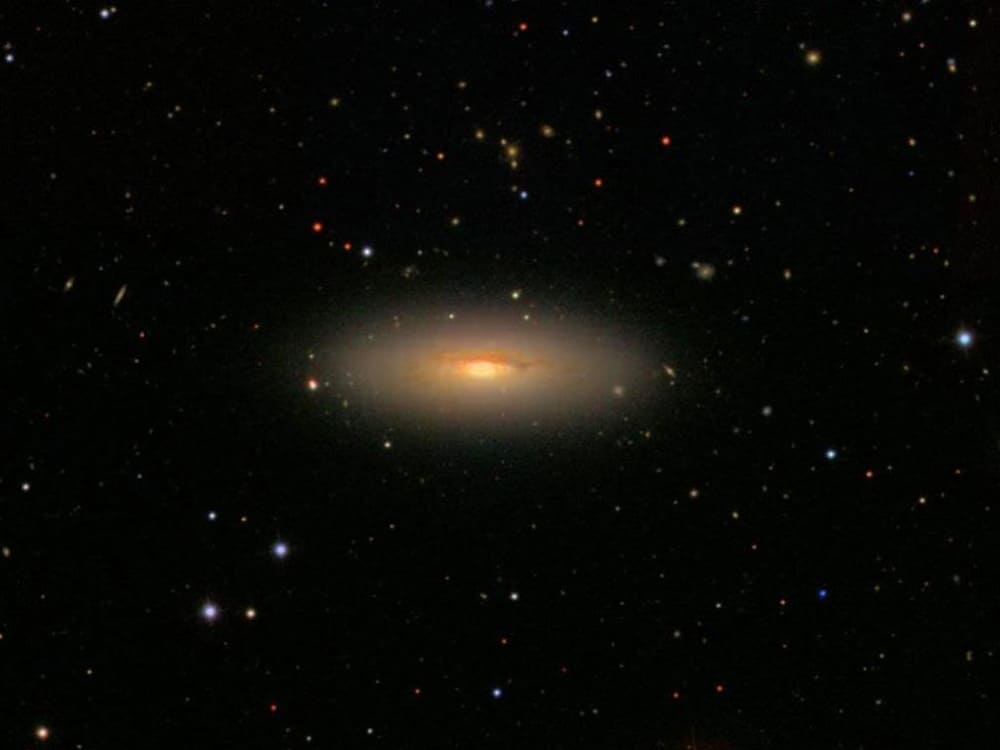
This galaxy is situated at around 20.5 million light-years away from us, and it has an apparent magnitude of 12.6.
NGC 3384
NGC 3384 is an elliptical galaxy that was discovered in 1784 by William Herschel. More than 80% of this galaxy’s stars appear to be Population II stars, which are over one billion years old.
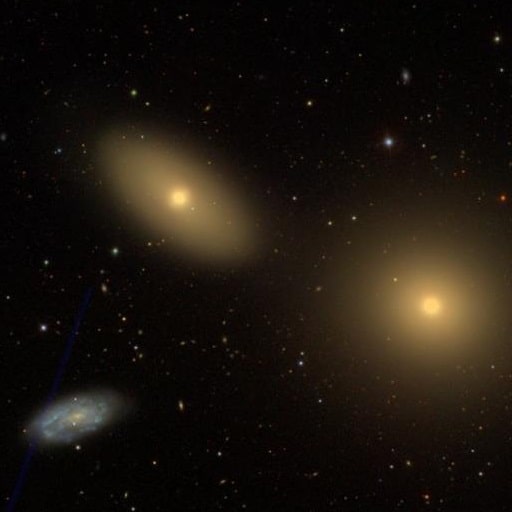
NGC 3384 is a member of the M96 Group, a group of galaxies that is sometimes referred to as the Leo I Group. This galaxy is located at around 35.1 million light-years away, and it has an apparent magnitude of 10.9.
NGC 3842
NGC 3842 is an elliptical galaxy that contains one of the largest black holes ever detected, reported to have 9.7 billion solar masses. This galaxy is the brightest member of the Leo Cluster.
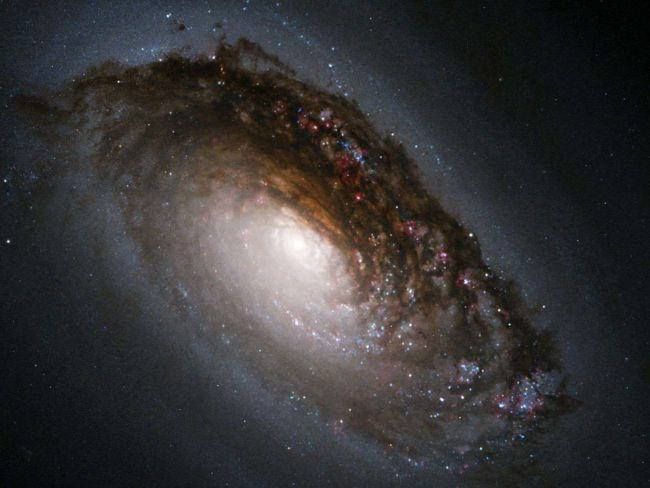
NGC 3842 is located at around 325 million light-years away from us, and it has an apparent magnitude of 12.78.
NGC 3626
NGC 3626, also known as Caldwell 40, is a medium-tightness spiral galaxy, located near the fourth brightest star in Leo, Zosma / Delta Leonis.
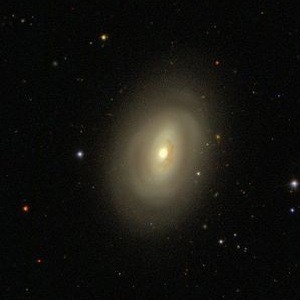
NGC 3626 is part of the NGC 3607 group, which is itself part of the many Leo II groups of galaxies. This galaxy is located at around 70 million light-years away from us, and it has an apparent magnitude of +10.6.
Meteor Showers
The constellation of Leo is associated with two meteor showers, the Leonids, and the January Leonids. The Leonids occur in November, peaking on November 14-15, and have a radiant close to Gamma Leonis / Algieba.
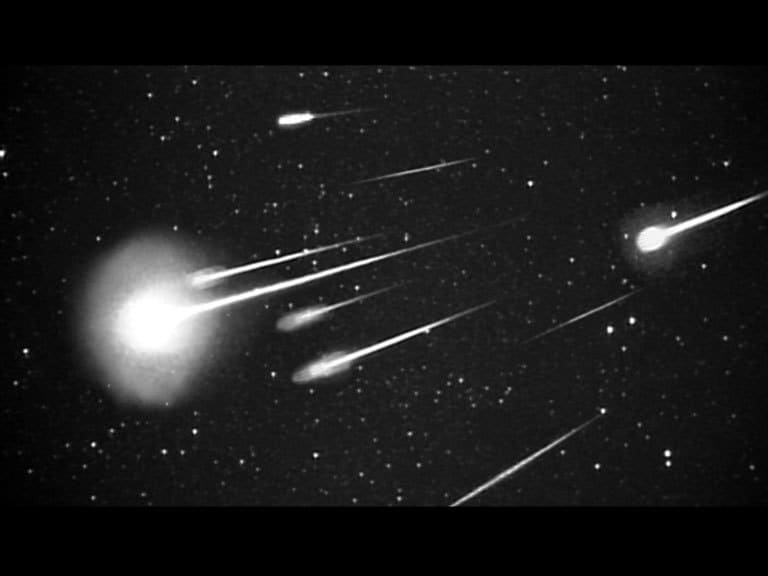
The parent body of these meteors appears to be the comet Tempel-Tuttle, which causes significant outbursts every 35 years or so. The normal peak rate is around 10 meteors per hour. The January Leonids are minor meteor showers, which peaks between January 1 – 7.
Astrology
As of 2002, the Sun appears in the constellation of Leo from August 10 to September 15. In tropical astrology, the Sun is considered to be in the sign of Leo from July 23 to August 22, and in sidereal astrology, from August 16 to September 17.
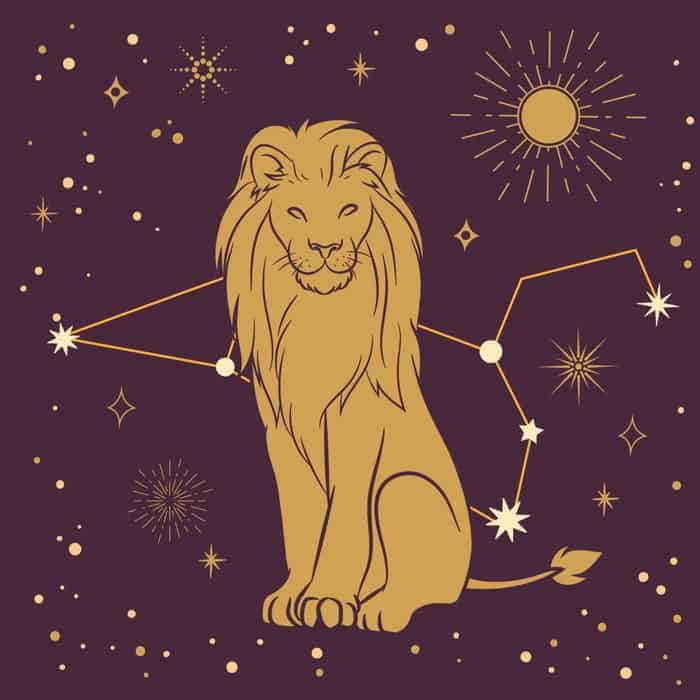
Did you know?
- The famous Sickle asterism in Leo is formed by six stars: Epsilon Leonis, Mu Leonis, Zeta Leonis, Gamma Leonis, Eta Leonis, and Alpha Leonis. The celestial lion’s tail is marked by Beta Leonis / Denebola – and the rest of its body is delineated by Delta Leonis and Theta Leonis.
- The Persians called the constellation of Leo, Ser, or Shir, the Turks called it Artan, the Syrians Aryo, the Jews Arye, while the Indians Simha – all of these names translate to the lion.
- A couple of mythologists believe that in Sumeria, Leo represented the monster Humbaba, who was killed by Gilgamesh.
- In Babylonian astronomy, Leo was called UR.GU.LA, the “Great Lion” – the bright star Regulus was known as “the star that stands at Lion’s breast” – Regulus was also known as the King Star.
- The Roman poet Ovid called the constellation Hercules Leo and Violentus Leo – Bacchi Sidus ( the star of Bacchus) was another title for Leo, representing the god Bacchus which has always been associated with this animal.
- The Roman Poet Marcus Manilius called Leo – Jovis et Junois Sidus – Star of Jupiter and Juno.
Sources:
Image Sources:
- https://telescopeobserver.com/wp-content/uploads/2019/06/leo-constellation.jpg
- https://upload.wikimedia.org/wikipedia/en/4/40/Hercules_and_Nemean_Lion_Stamp.jpg
- https://upload.wikimedia.org/wikipedia/commons/thumb/a/a8/LeoCC.jpg/220px-LeoCC.jpg
- https://www.astronomytrek.com/wp-content/uploads/2018/04/Spring-Constellations-657×381.jpg
- https://upload.wikimedia.org/wikipedia/commons/a/af/Messier_65_through_the_years.jpg
- https://upload.wikimedia.org/wikipedia/commons/7/7c/Phot-33c-03-fullres.jpg
- https://upload.wikimedia.org/wikipedia/commons/3/3c/Messier95_spitzer.jpg
- https://www.nasa.gov/sites/default/files/styles/full_width/public/thumbnails/image/potw1535a.jpg?itok=SCptJsa4
- https://www.messier-objects.com/wp-content/uploads/2015/09/M105-NGC-3384-and-NGC-3389.jpg
- https://astrologyking.com/wp-content/uploads/leo-constellation.jpg
- https://media5.newsnationtv.com/images/2017/09/19/108028415-Regulusstarspinningfast.jpg
- https://upload.wikimedia.org/wikipedia/commons/b/b4/Spring_Triangle_%28Stellarium%29.png
- https://cdn.steamboatpilot.com/wp-content/uploads/sites/8/2017/06/030211_westlake.jpg
- https://www.star-facts.com/wp-content/uploads/2020/04/Denebola-1240×620.jpg?189db0&189db0
- https://www.constellationsofwords.com/images/stars/denebola.JPG
- https://upload.wikimedia.org/wikipedia/commons/2/24/Great_Diamond_map.gif
- https://i.pinimg.com/originals/82/01/2a/82012abd4b0b4e9bbe94a36d650d44e8.png
- https://vignette.wikia.nocookie.net/startrek/images/9/9a/A_class_star.jpg/revision/latest/top-crop/width/360/height/450?cb=20111117183251
- https://theskylive.com/sky/stars/finder-charts/epsilon-leonis-finder-chart.png?c=1586722081
- https://alchetron.com/cdn/delta-leonis-3352fb1d-ef5c-4700-ac60-02b6d4357ce-resize-750.jpeg
- https://www.cloudynights.com/uploads/monthly_03_2011/post-167013-14073328569732.jpg
- https://theskylive.com/sky/stars/star-images/44/4418_800.jpg
- https://theskylive.com/sky/stars/star-images/39/3905_800.jpg
- https://www.messier-objects.com/wp-content/uploads/2015/09/Messier-105.jpg
- https://i2.wp.com/www.drewexmachina.com/wp-content/uploads/2015/11/Red_dwarf_feature.jpg?resize=890%2C500&ssl=1
- https://i1.wp.com/www.drewexmachina.com/wp-content/uploads/2016/01/red_dwarf_planet_feature.jpg?fit=890%2C500&ssl=1
- https://upload.wikimedia.org/wikipedia/commons/thumb/e/e4/R_Leonis_evaporating_planet.png/260px-R_Leonis_evaporating_planet.png
- https://machprinciple.files.wordpress.com/2013/11/gliese-436-b-11.jpg?w=547
- https://upload.wikimedia.org/wikipedia/commons/thumb/d/d8/CW_Leonis_UV.jpg/640px-CW_Leonis_UV.jpg
- https://astronomicamens.files.wordpress.com/2013/04/giant_star.jpg
- https://upload.wikimedia.org/wikipedia/it/thumb/c/c7/IC_4592.jpg/220px-IC_4592.jpg
- https://upload.wikimedia.org/wikipedia/commons/1/1e/NGC_3628_The_Oddest_Member_of_the_Leo_Triplet.jpg
- https://upload.wikimedia.org/wikipedia/commons/0/0f/Leo_Ring.jpg
- https://apod.nasa.gov/apod/image/1504/N2903JewelofLeo_hallas_c.jpg
- https://upload.wikimedia.org/wikipedia/commons/thumb/3/38/Artist%27s_rendering_ULAS_J1120%2B0641.jpg/440px-Artist%27s_rendering_ULAS_J1120%2B0641.jpg
- https://upload.wikimedia.org/wikipedia/commons/thumb/b/b9/Magnifying_the_distant_Universe.jpg/600px-Magnifying_the_distant_Universe.jpg
- https://upload.wikimedia.org/wikipedia/commons/thumb/7/77/Best_image_of_bright_quasar_3C_273.jpg/486px-Best_image_of_bright_quasar_3C_273.jpg
- https://upload.wikimedia.org/wikipedia/commons/f/fd/Hubble_image_of_MACS_J0717_with_mass_overlay.jpg
- https://www.jwinman.com/starcharts/images/NGC%203593.jpg
- https://upload.wikimedia.org/wikipedia/commons/f/f4/M105%2C_NGC_3384_%26_NGC_3389.jpg
- https://i.pinimg.com/originals/f6/6a/9d/f66a9d9c8aa15651b0b181ef86af5fe0.jpg
- https://freestarcharts.com/images/Articles/NGC/NGC3626_SDSS.jpg
- https://solarsystem.nasa.gov/system/content_pages/main_images/462_leonids_main.jpg
- https://mixkit.imgix.net/art/preview/mixkit-leo-zodiac-star-sign-501-original-large.png?q=80&auto=format%2Ccompress&h=700
